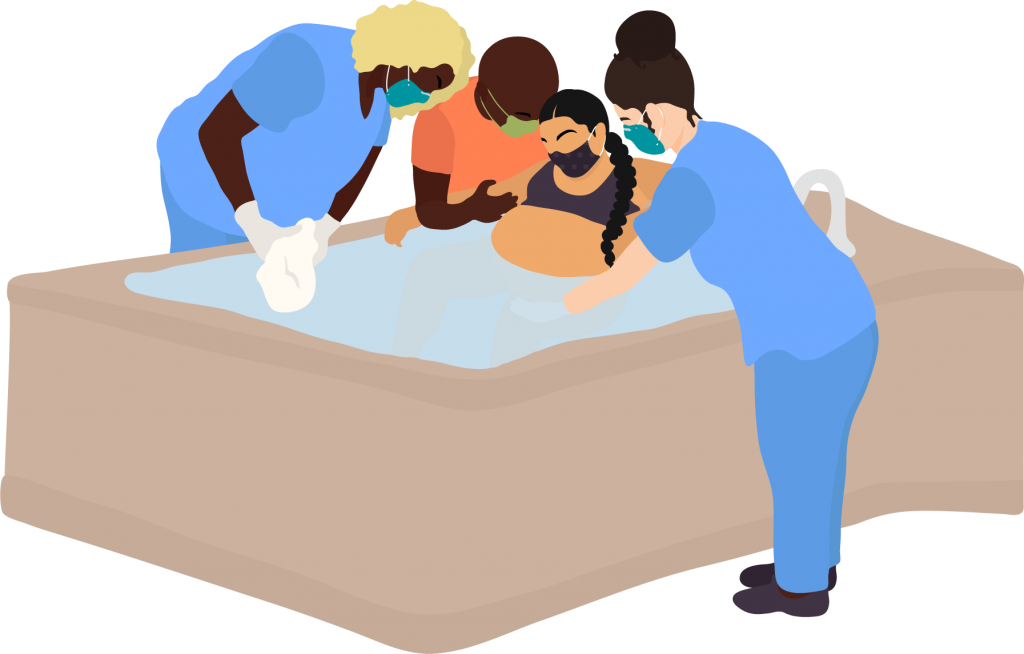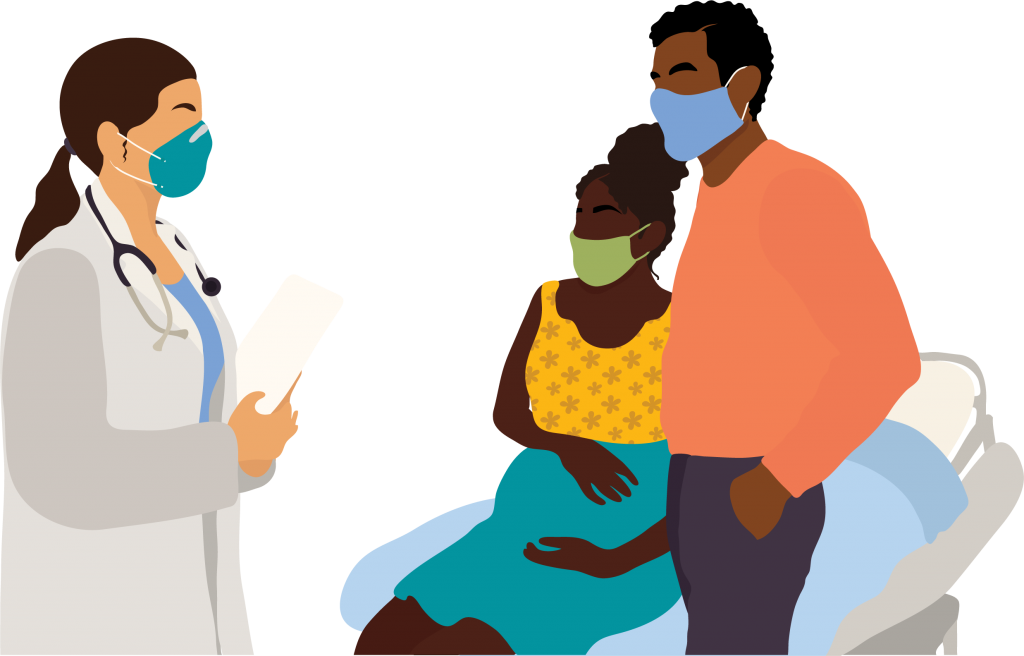
The birth of a baby is one of life’s most exciting experiences. There are several types of birth to choose from, which is lovely – but it can also be overwhelming to choose the birth option that is best for you.
We’re very good at delivering babies at The Mother Baby Center, so we’re happy you found us! Here’s some helpful information about the most common birth methods and other things you might want to consider as you plan for your baby’s arrival.
It’s essential to think about the different ways to give birth early in your pregnancy. Consider where you’d like to deliver your baby – in a hospital, in a birth center, or at home – and how you feel about various medical interventions during childbirth.
Ideally, you’ll have an easy birth with a perfectly executed birth plan. But sometimes, a planned birth can have twists and turns, so it’s important to be prepared for other methods of birth just in case.

Five childbirth options explained
Today, mothers are offered a variety of childbirth options. The Mother Baby Center offers the following childbirth choices:
You’ll want to weigh the risks and benefits of each method of delivery along with the mother’s preferences to determine a safe and healthy way to give birth for you and your baby. Most women decide on their birthing method in advance, but some women wait to see how labor is going before making decisions with their doctor, midwife or doula.

Vaginal birth
Vaginal birth delivery is the most common type of delivery. In a vaginal birth, the baby is born through the birth canal. Labor can be a straightforward, uncomplicated process for the mother’s body but may require medical assistance at some point.
“Natural childbirth” is a vaginal delivery without medication, like an epidural to numb pain or an induction to start the labor process. Other assisted delivery procedures that might arise during a vaginal birth include:
- An episiotomy: a surgical incision made in the perineum (the area of skin between the vagina and anus) to enlarge the vaginal opening
- An amniotomy: “breaking of the water” or artificial rupture of the amniotic membranes that contain the fluid surrounding the baby. This can induce labor and/or allow the health care provider to assess and monitor the baby’s well-being
Pros
The benefits of a vaginal birth delivery include:
- Shorter hospital stays
- Lower infection rates
- Quicker recovery
- Babies born vaginally have a lower risk of respiratory problems
- A vaginal delivery can provide a unique and personalized experience for the mother, baby, and partner/family
Cons
Some challenges with vaginal birth delivery include:
- Vaginal birth is painful. However, the pain is short-lived, and there are many methods to reduce the intensity of childbirth pain
- Possible tearing of the perineum
- Sometimes babies arrive quickly! As your due date approaches, you will have conversations with your doctor or midwife about labor symptoms and the plan for when your labor begins
Water birth
During a water birth delivery, the mother labors in a tub of water similar to a hot tub. The mother can relax in warm water and feel the buoyancy and freedom of movement during and between contractions. The baby can be delivered underwater, or the mother can get out of the water and deliver in a different position. This method of childbirth can be performed in hospitals, birthing centers, and at home.
Pros
The benefits of a water birth delivery include:
- It is thought to be less painful and more relaxed for many women
- Freedom of movement
- Safe and effective pain management
- Reduces blood pressure
Cons
Some challenges with a water birth delivery include:
- Logistics to set up the birthing tub can be complex if not at a birth center or hospital.
- Unable to use epidural anesthesia for pain or induction medications
- Some critics of water births are concerned about an increased risk of infection.
- If the birth plan does not progress normally, it may require transporting the mother to the hospital (if at a birth center or home).
Cesarean section
A cesarean section or C-section birthing option is the delivery of a baby through a surgical incision in the mother’s abdomen and uterus. Sometimes a C-section is scheduled in advance; other times, it’s done in response to an unforeseen complication.
A C-section birth is often done for multiple babies (twins, triplets, etc.) or a very large baby. It’s also done if the baby is in breech (bottom first) or transverse (sideways) position. There could be other medical reasons to perform a cesarean birth to protect the mother’s or baby’s health.
Pros
The benefits of a cesarean section delivery include:
- A vaginal birth delivery isn’t always possible, and a C-section is a good option for a safe birth.
- A scheduled C-section allows you to plan and prepare without feeling rushed.
Cons
The challenges of a cesarean section delivery include:
- Longer hospital stay after delivery (three days)
- Full recovery can take eight weeks
- Recovery can be painful and challenging while caring for a newborn
Vaginal birth after C-section
Vaginal birth after cesarean (VBAC) is possible for some women. The best candidates for a VBAC are women who have undergone only one prior C-section and are currently experiencing a healthy, problem-free pregnancy. The most important criteria for choosing a VBAC is the reason for your previous C-section is not a factor with this pregnancy.
Pros
The benefits of a VBAC compared to a repeat C-section include:
- Fewer complications, including a reduced risk of infection and less blood loss
- Shorter recovery time and hospital stay
- Greater participation in the birth process, including holding and breastfeeding your baby sooner
- Repeat C-sections get more complicated each time, so if you’re planning to have more children repeat VBACS tend to become progressively easier.
Cons
The challenges of a VBAC include:
- Vaginal delivery after cesarean is not suitable for a woman who has had more than one C-section
- If the reason for your previous C-section is also a factor in your current pregnancy, you cannot have a vaginal delivery
- Once you’ve had a cesarean delivery, your risk of uterine rupture goes up during future vaginal deliveries
Scheduled induction
Sometimes a baby needs extra encouragement to make its grand entrance. If you have gone past your due date and you and your baby are ready, your doctor might schedule an induction, which involves a medication called Pitocin to start your labor. On your induction day, you’ll be admitted to the birth center and receive Pitocin through an IV. Your contractions will begin soon, and you will be in active labor. Unless medically necessary, inductions are not done before the 39th week of pregnancy.
Learn more about labor inductions – what you need to know and what to expect.
Pros
The benefits of a scheduled induction include:
- Your baby is finally ready to meet you!
- The procedure is safe. You and your baby will be carefully monitored by your doctor and nurses
- A scheduled induction allows you to plan and prepare without feeling rushed
Cons
The challenges of a scheduled induction include:
- The procedure requires Pitocin, a labor-inducing hormone. Even though this medication is known to be safe for mother and baby, some women prefer no medications during childbirth
- Some mothers (and partners) prefer not to have a scheduled birth
- A scheduled induction might mean you or your baby have other health issues that need monitoring or treating.

Tips to choose the right birthing method
You’re busy making many big decisions during your pregnancy – and considering the childbirth delivery method that is right for you is one of your most important decisions. Now is the perfect time to learn about the different types of births and talk to your health care provider about your preferences and concerns.
- Attend childbirth preparation classes. You will learn about the types of pregnancy delivery as well as breathing and relaxation techniques to use during labor.
- Review a birth plan worksheet. This can help you think through your labor, delivery, and postpartum preferences.
- Talk to other mothers about their childbirth experiences. They are the experts!
- Remember, even the most carefully considered birth plan could be changed at the last minute if it’s necessary to keep you or your baby safe during delivery. And that’s okay because you will finally be meeting your beautiful baby!

Explore delivery options at The Mother Baby Center
At The Mother Baby Center, we are here to do everything possible to bring your personal birth journey to life. Our goal is healthy babies, parents, and caregivers. Our expert guidance and support will help you navigate your childbirth options and arrive at your delivery day confident you are receiving the best care for you and your baby. Find a provider at one of our locations or explore our blog for more inspiring stories and excellent advice!